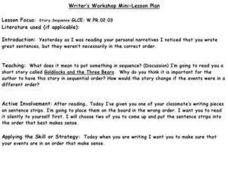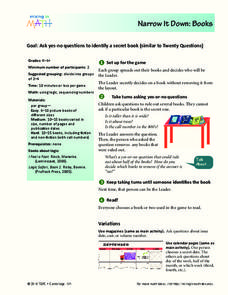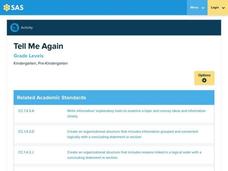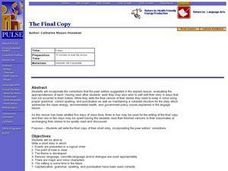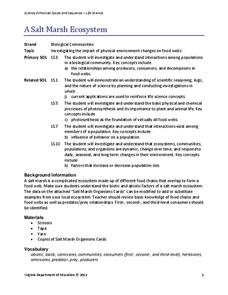Curated OER
Logical Sequence-- Lessons 1,2,3
In this language arts worksheet, students discover the importance of logical sequence in stories. Students read 5 short stories or letters and put them in the correct order. This is a cut and paste page.
EngageNY
Integer Sequences—Should You Believe in Patterns?
Help your class discover possible patterns in a sequence of numbers and then write an equation with a lesson plan that covers sequence notation and function notation. Graphs are used to represent the number patterns.
For the Teachers
Story Strips Sequencing
What happens next? Work on story sequence with a lesson that prompts kids to put a story back in order. Additionally, they discuss what would happen if one event was missing from the sequence.
For the Teachers
Sequence Plot Chart
Your kids can identify the plot sequence of a short story, but what about an informational article? Have them examine the chronological order of events in informational texts with a activity on the sequence of events.
Curated OER
Logical Sequence
Students examine logical and illogical sequences in writing. They identify illogical sequences of sentences in a letter. Students retell short stories using a logical sequence and students place sentences in logical order.
EngageNY
Correspondence and Transformations
Looking for a strategy to organize the information related to transformations? The materials ask pupils to identify a sequence of rigid transformations, identify corresponding angles and sides, and write a congruence statement. They...
Curated OER
Sunrise Sequencing
Students examine sequencing events by discussing what they do each morning. They complete a four-panel sequence of events assignment, drawing a picture and writing a sentence for each box in the panel.
Curated OER
Writers Workshop Story Sequence
Students read stories and explore the importance of sequential order. In groups, students are given sentence strips. Students holding the sentence strips, place themselves in a logical order to make a story. Individually, students...
Curated OER
The Beginning, The Middle, & The End
Cut magazine pictures into three sections, having your youngsters piece the pictures back together. With this fun activity, they discover the importance of sequencing a story. Then they use a fun template (shaped like a burger) to write...
Think Like A Programmer! Puzzlets Cork the Volcano Curriculum
Common Core Standards Connected
The standards listed below are standards from the Common Core Framework which map to learning opportunities with Cork The Volcano & Puzzlets.
Source Link:...
Curated OER
Solving a Simple Maze
It is a-maze-ing how lost one can get. Teams reconstruct a simple maze and solve it. Participants create an algorithm that a robot would follow in order to solve the maze as well. The activity includes an extension directing pupils to...
Curated OER
Chef for a Day
Students make chocolate chip cookies. In this cooking lesson, students follow a recipe by doing each step in sequence.
Curated OER
Narrow It Down: Books
Students ask yes-no questions to identify a secret book. In this asking questions lesson plan, students ask yes or no questions about books to identify a secret book. Students identify the book and then read one of the example books.
Pennsylvania Department of Education
Tell Me Again
Students demonstrate how to retell a story in sequential order. In this reading comprehension lesson, students listen to a suggested read aloud, such as Little Boy Blue. Additionally, students practice retelling the story by using...
Curated OER
The Final Copy
Write short stories in which events are presented in logical order, point of view is clear, theme and characters are developed. Middle schoolers also work on sensory language, concrete language and/or dialogue. They establish their...
Curated OER
The Very Hungry Caterpillar
Here is a good activity on butterflies and caterpillars. After listening to The Very Hungry Caterpillar, young learners put cards that depict the life cycle of a butterfly in the correct order. There are some good ideas for center...
Curated OER
Understanding and Using Root Words to Expand Vocabulary
Middle schoolers engage in a lesson which reminds them that root words indicate the base meaning of a word, and that those roots are found in many different words that have similar meanings. Pairs of pupils use construction paper and...
Virginia Department of Education
A Salt Marsh Ecosystem
What a web we weave. Pupils use yarn as the primary resource to create a web depicting the intricacies of a salt marsh ecosystem. They participate in a question and answer session, which leads to an in-depth facilitated discussion...
Curated OER
The Day Jimmy's Boa Ate the Wash
Students read the story The Day Jimmy's Boa At the Wash and put the event boxes in order from the beginning to end of the story. In this sequencing lesson plan, students do this on the computer.
Pennsylvania Department of Education
6 Traits: Organization
Students make logical patterns in their writing to demonstrate the trait of organization. In this organization lesson plan, students focus on events proceeding logically.
Curated OER
Narrative Nuts and Bolts
After viewing slides and reading about child labor, young authors compose an original narrative story. They practice note-taking skills and work to effectively engage a reader by incorporating plot, logical order, complex characters,...
Curated OER
Alphabet Sideshow
Students practice sound and recognition of letters in alphabetical sequence. They gain an understanding of letter sounds and order. They create a slide show with graphics and text. They present their slide show to the class.
Curated OER
Shell Sort; Serving up Seafood
Students complete various small group activities to classify items and determine the types of combinations that can be made with these items. In the second lesson, students create menus for a restaurant to help them gain money sense and...
Curated OER
Drafting
Students use transitions to connect the beginning, middle and end of their writing. In this lesson on drafting a story, students use a graphic organizer sandwich to put pictures back together and recognize a specific order.







